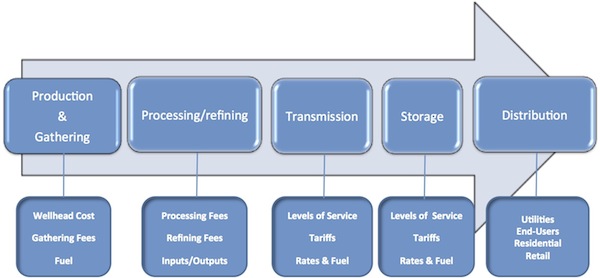Overview
The term “logistics” has become more and more popular to define the process whereby goods move from the point of manufacturing and production to the point of sale and consumption. UPS® and FedEx® are no longer just in the package shipping business. They now provide a full range of services, from receiving parcels to transporting them via truck, rail and plane, to storing them in warehouses and ultimately, distributing them to their final destinations. All the while, they are tracking packages throughout the entire process, which can also be done by their customers.
The delivery system for energy commodities is no different, as products—either from the wellhead, plant, or refinery—are transported using various methods, stored, and ultimately distributed to places of final consumption. As we explore the ways and methods in which energy commodities are delivered to market, you will see this same basic theme consistently applied.
Additionally, we will learn the “value chain” for energy commodities. That is, what are the costs and revenues along this delivery path?

Figure 1: Overall Energy Commodity Logistics Chart - Crude Oil
Source: Dutton e-Education Institute
This graphic illustrates the various steps in the "wellhead-to-burnertip" logistical path for oil and natural gas: aggregation (gathering), the "cleaning" of the raw stream and production of valuable natural gas liquids (NGLs) and, the steps for getting crude oil and natural gas from the wells all the way to market. As you can see, there is processing of natural gas or refining of crude, the transportation and storage and, finally, the distribution and retail delivery to the various end-users. As you will see, each step along this "path" will have some costs associated with it and most will represent an opportunity for generating revenue. These will add to the total profit that can be derived from the initial wellhead production.
Learning Outcomes
At the successful completion of this lesson, students should be able to:
- Define the steps in the movement of crude oil from the wellhead to the end-user (“pump-to-pump” path).
- Recognize the “value chain” along the path.
- Understand the general methods of transporting crude oil from well to refinery.
- Trucks
- Pipeline
- Rail
- Barge
- Tanker
What is due for Lesson 3?
This lesson will take us one week to complete. There are a number of required activities in this module. The chart below provides an overview of the activities for Lesson 3. For assignment details, refer to the location noted.
All assignments will be due Sunday, 11:59 p.m. Eastern Time.
REQUIREMENT | LOCATION | SUBMITTING YOUR WORK |
|---|---|---|
| Reading Assignment: Crude Oil Refining Process | Lesson 3 Reading Assignment page | No submission |
| Mini-lecture: Crude Oil | Mini-Lecture: Crude Oil page | No submission |
| Mini-lecture: Crude Oil Refining | Mini-Lecture: Crude Oil Refining page | No submission |
| Lesson 3 Activity | Lesson 3 Activity page | Submitted through the course blog |
| Lesson 3 Quiz | Summary and Final tasks page | Submitted through ANGEL |
| Discussion forum participation | Course Blog | Submitted through the course blog |
Questions?
If you have any questions, please post them to our Questions? discussion forum (not e-mail), located under the Communicate tab in ANGEL. The TA and I will check that discussion forum daily to respond. While you are there, feel free to post your own responses if you, too, are able to help out a classmate.